Special Report
The States Where It’s Best (and Worst) to Be a Teacher

Published:
Last Updated:

A career in teaching means having an impact on the next generation — providing young people with the tools to succeed as members of society and engaging students in learning every day. More than 3 million public school teachers serve this vital purpose in the United States.
Despite being so highly valued, teaching professions are among the lowest paying jobs for college graduates. And though most agree that educating children is of utmost importance, public school funding is a major problem in the United States — especially in low-income communities.
The recent and ongoing wave of teacher strikes that swept the nation last year and since in states like West Virginia, Arizona, and Oklahoma (each among the lowest paying states for teachers), demonstrates that in some states compensation structures and working conditions for teachers are a serious issue. The states with relatively low per-pupil funding frequently rank among the states with the worst schools.
Pay isn’t the only factor determining the quality and desirability of a teaching job. Class sizes, pensions, and more general working conditions are all important when gauging what it’s like to be a teacher.
To identify the states where it’s best (and worst) to be a teacher, 24/7 Tempo constructed an index of average annual teacher pay, student-teacher ratio, the percentage of new teachers who are expected to qualify for a pension, and the overall state quality grade given to each state by research and policy group the National Council for Teacher Quality’s in its 2017 annual report. We ranked the states based on our index.
Click here to see the states where it’s best to be a teacher.
Click here to see the states where it’s worst to be a teacher.
Click here to see our full methodology.

15. Michigan
> Average teacher pay: $69,524 (9th highest)
> Student-teacher ratio: 33 to 1 (8th highest)
> New teachers expected to qualify for a pension: 50.0% (19th highest)
> High school graduation rate: 80.2% (9th lowest)
Slightly over half of the just over 75,000 teachers employed in Michigan work in elementary schools, the sixth highest share in the United States. Nationwide, 45.9% of teachers work in elementary school. Many teachers prefer elementary to middle school, where they don’t have to deal with students entering puberty who can be moodier, according to the Centers for Disease Control and Prevention, and therefore perhaps more difficult to discipline.
Overall, teachers in Michigan are well paid. The state’s average teacher salary, which was adjusted to the cost of living, is the ninth highest in the country.
[in-text-ad]

14. Pennsylvania
> Average teacher pay: $67,318 (10th highest)
> Student-teacher ratio: 26 to 1 (21st lowest)
> New teachers expected to qualify for a pension: 36.0% (17th lowest)
> High school graduation rate: 86.6% (22nd highest)
On average, Pennsylvania’s 127,300 teachers make between $3,000 and $5,000 more annually than the average teachers’ salary nationwide. In addition to the higher salaries, secondary school teachers and those in special education may choose to work in the Keystone State because it has stricter requirements for licencing teachers, which makes them better prepared for teaching. Most other states received lower grades for preparing their educators to teach in these two categories.
Pennsylvania’s teacher and principal evaluation grade was a C+, which is among the highest compared to all states. The evaluation measures student growth based on the effectiveness of the instructor, teachers’ professional development, as well as principal effectiveness.

13. Missouri
> Average teacher pay: $58,911 (22nd lowest)
> Student-teacher ratio: 24 to 1 (11th lowest)
> New teachers expected to qualify for a pension: 58.0% (9th highest)
> High school graduation rate: 88.3% (12th highest)
Even though teachers in Missouri make less than the U.S. average teacher’s salary of about $63,000 annually, the student-teacher ratio of 24 to 1 is one of the lowest of all states. Educators often prefer small class sizes because they can then pay more attention to individual students and spend less time dealing with disruptions in class.
Abou 58.0% of new teachers in Missouri are expected to remain in the profession long enough to qualify for retirement benefits, the ninth highest share among all states.

12. Arkansas
> Average teacher pay: $57,543 (16th lowest)
> Student-teacher ratio: 25 to 1 (14th lowest)
> New teachers expected to qualify for a pension: 57.0% (10th highest)
> High school graduation rate: 88.0% (14th highest)
Though teachers’ pay in Arkansas, adjusted for cost of living, is relatively low compared to the national average, the average class size is one of the best. Smaller class sizes have been shown to be beneficial not just to students’ learning environment, but also to teachers’ working environment. The state also ranks high in percentage of new teachers who may qualify for retirement benefits.
Arkansas is one of two states to receive the highest grade for education policies, including making sure secondary school teachers, especially those teaching science and social studies, are qualified to teach and actually know the appropriate grade material. Stricter requirements usually result in more qualified teachers.
[in-text-ad-2]
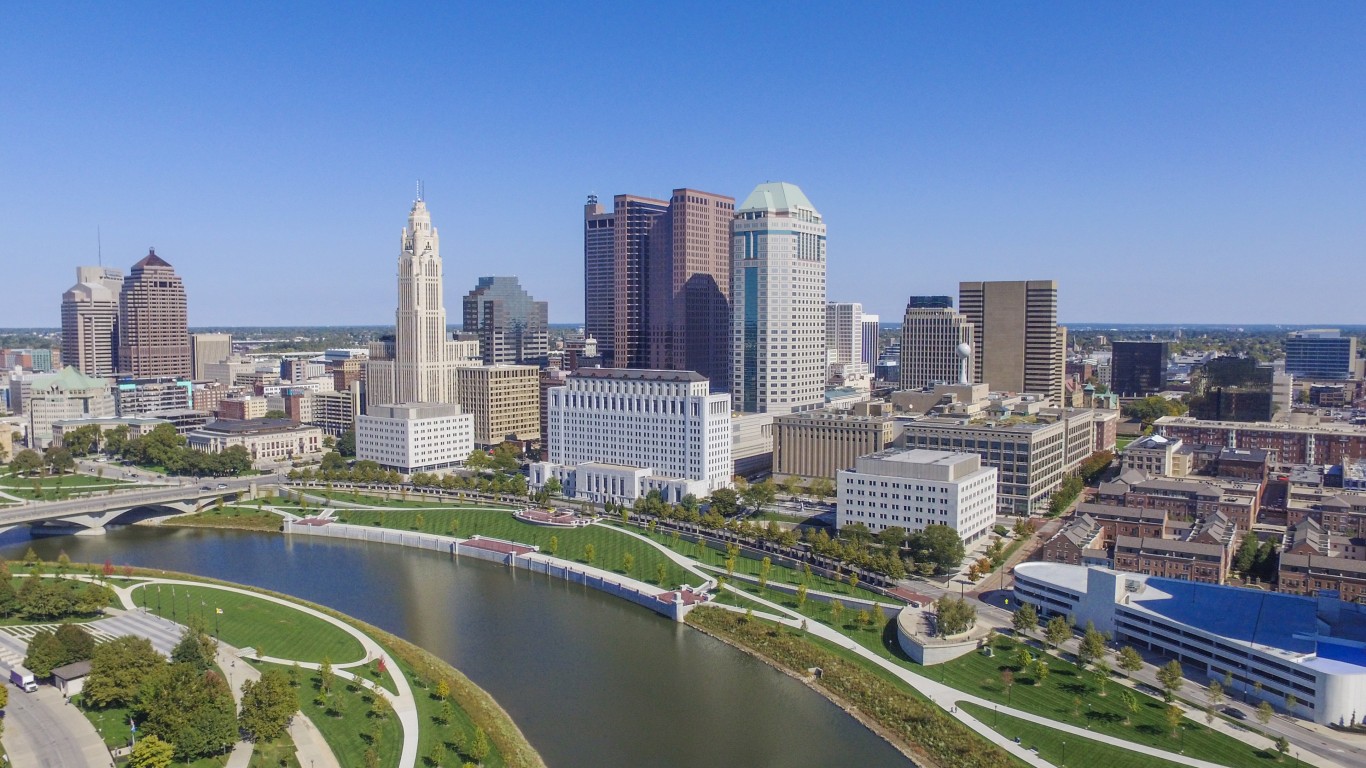
11. Ohio
> Average teacher pay: $69,617 (7th highest)
> Student-teacher ratio: 30 to 1 (13th highest)
> New teachers expected to qualify for a pension: 34.0% (14th lowest)
> High school graduation rate: 84.2% (23rd lowest)
Money may be a good incentive to work in teaching in Ohio. The average pay, adjusted to the cost of living in the state, is almost $70,000, the seventh highest in the country and about $7,000 more than the average pay for teachers nationwide.
Another good motive for teachers in the state is their retirement. Though the length of teaching requirement for collecting unreduced benefits at any age will increase, the average benefit for newly retired teachers in Ohio is the highest in the country at more than $66,000 annually.

10. Texas
> Average teacher pay: $58,948 (23rd lowest)
> Student-teacher ratio: 27 to 1 (24th lowest)
> New teachers expected to qualify for a pension: 59.0% (7th highest)
> High school graduation rate: 89.7% (4th highest)
The best states to be a teacher do not necessarily report the best outcomes for students — the picture is often mixed. Texas is one such example. Though just 26.5% of fourth graders score proficient level on the standardized test NAEP — nearly the lowest share, the state’s high school graduation rate of 89.7% is fourth highest of all states.
Nearly 60.0% of new teachers in Texas are expected to remain in the teaching profession long enough to retire and qualify for pension benefits, one of the highest such percentages in the nation and a major factor in the state’s top 10 ranking. Additionally, the National Council on Teacher Quality identified secondary teacher preparation as among Texas’s major strengths. For example, state policies promote teacher quality by requiring middle school teachers to pass a rigorous single-subject content test.
[in-text-ad]
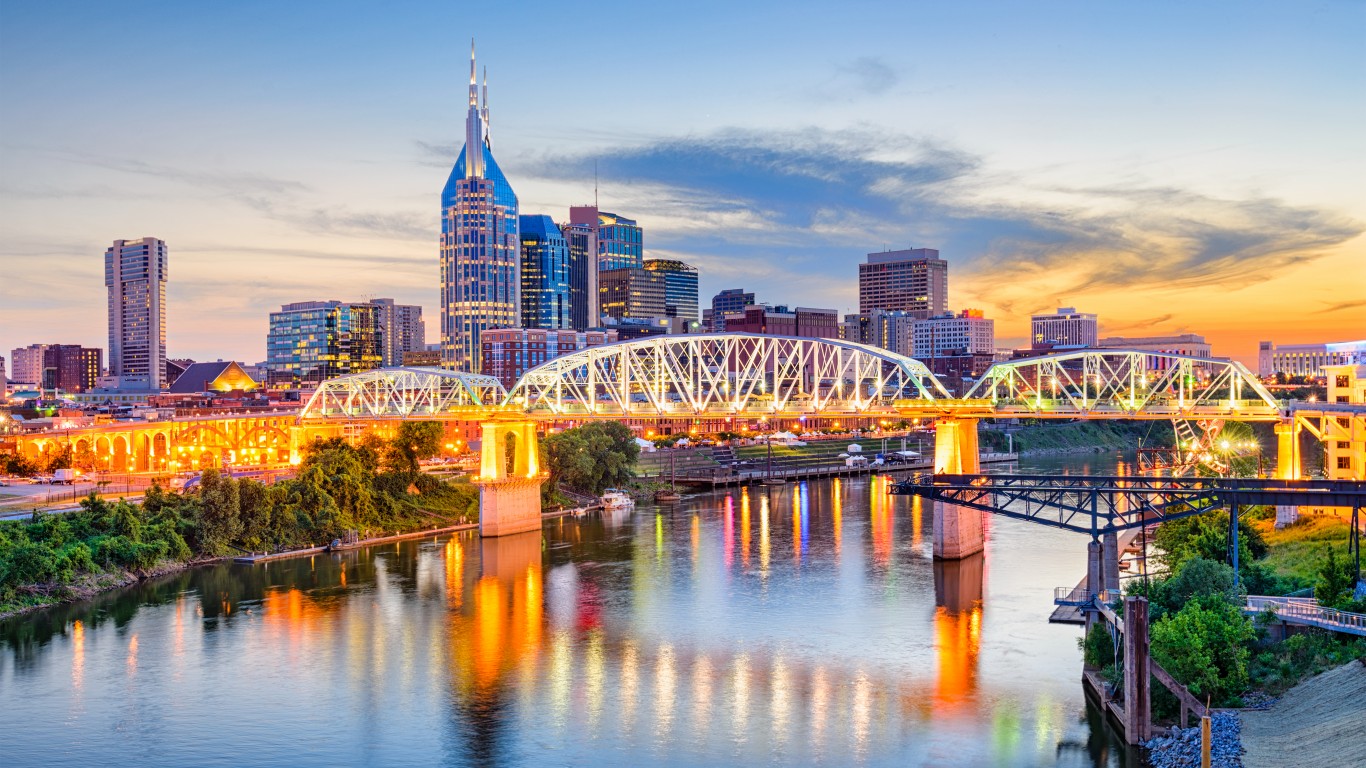
9. Tennessee
> Average teacher pay: $58,618 (21st lowest)
> Student-teacher ratio: 28 to 1 (20th highest)
> New teachers expected to qualify for a pension: 56.0% (12th highest)
> High school graduation rate: 89.8% (3rd highest)
Tennessee is the only state the National Council on Teacher Quality has given an A- grade for its policies on general teacher preparation, the best of all states. The report identifies the state’s programs to increase diversity among its teachers and to meet performance standards as Tennessee’s strengths.
More than half of new teachers (56.0%) are expected to remain teachers long enough to qualify for retirement benefits in Tennessee, the 12th highest share in the country.
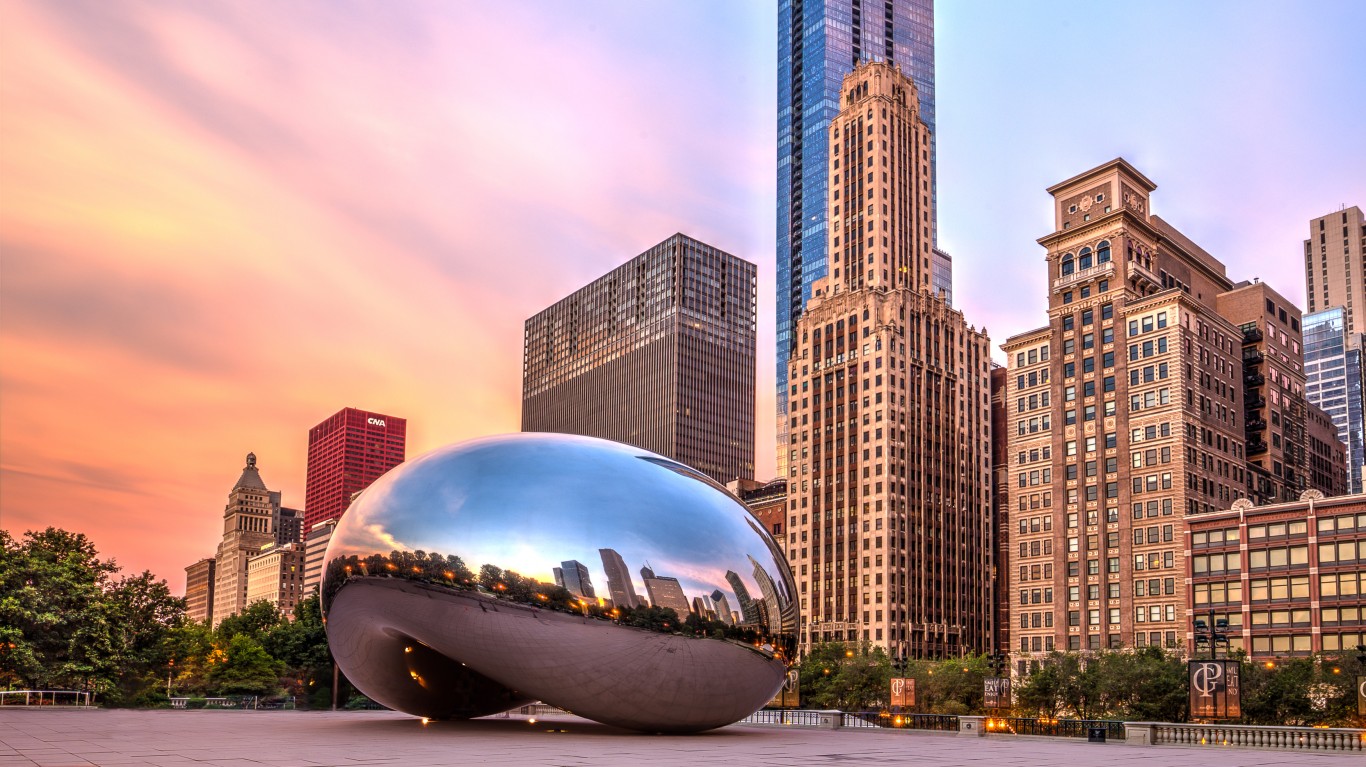
8. Illinois
> Average teacher pay: $66,561 (11th highest)
> Student-teacher ratio: 28 to 1 (18th highest)
> New teachers expected to qualify for a pension: 50.0% (19th highest)
> High school graduation rate: 87.0% (18th highest)
Compared to the average pay of teachers nationwide of $63,000 a year, educators in Illinois are fairly well compensated. The average annual pay in the state, adjusted to the cost of living, is $66,560, the 11th highest in the country.
In addition to relatively good pay, retirement benefits are also relatively high. The median annual retirement benefit for newly retired teachers in Illinois is more than $55,000, the highest of all states. The high benefit amount may explain the state’s relatively high percentage of teachers expected to stay in the profession long enough to qualify for a pension, which at 50.0% is higher than most states.

7. Louisiana
> Average teacher pay: $55,177 (12th lowest)
> Student-teacher ratio: 26 to 1 (22nd lowest)
> New teachers expected to qualify for a pension: 54.0% (16th highest)
> High school graduation rate: 78.1% (4th lowest)
In its annual evaluation of state education policy goals, The National Council on Teacher Quality awarded Louisiana an A for teacher compensation, contributing to an overall grade of B+, one of the better grades in the nation. Louisiana’s beneficial policies include rewards for effective teachers, options for teachers to earn higher pay for working in high-need schools, and incentives for districts to compensate new teachers who demonstrate prior work experience.
Despite these favorable policies, Louisiana’s public school teachers are paid exceptionally low salaries compared to other states on this list. The state’s cost of living adjusted average teacher pay is $55,177, the 12th lowest in the nation.
[in-text-ad-2]

6. Virginia
> Average teacher pay: $66,314 (12th highest)
> Student-teacher ratio: 25 to 1 (19th lowest)
> New teachers expected to qualify for a pension: 50.0% (19th highest)
> High school graduation rate: 86.9% (19th highest)
Virginia is the only state the National Council on Teacher Quality has given an A- grade for its policies on elementary teacher preparation, the best of all states. The report identifies the state’s programs to connect graduates’ growth data to their teacher preparation programs and requiring that all teacher evaluations include observations and possibly students survey data as Virginia’s strengths.
Teachers in Virginia are paid relatively well compared to the U.S. annual average teachers’ pay of about $63,000. Educators earn over $66,000 a year, the 12th highest adjusted to cost of living average pay in the country.

5. Massachusetts
> Average teacher pay: $75,006 (the highest)
> Student-teacher ratio: 24 to 1 (10th lowest)
> New teachers expected to qualify for a pension: 12.0% (the lowest)
> High school graduation rate: 88.3% (12th highest)
No state has better-paid teachers than Massachusetts, where the typical public school teacher earns $75,006 annually. This figure is the highest in the nation even after adjusting for the state’s relatively high cost of living. The relatively low student to teacher ratio in the state and the strong teacher quality assessments contribute to Massachusetts’ rank as one of the best states to be a teacher.
The state, however, could do much better in supporting its teachers with benefits like secure pension plans. Based on a recent study of the state’s pension system, idiosyncratic and hidden conditions in the pension formula result in 74% of state educators taking a loss when they receive their pension distributions. The 12% of new teachers expected to stay in the profession long enough to even receive a pension is the lowest in the nation and exceptionally poor compared to the other best states to be a teacher.
[in-text-ad]

4. Connecticut
> Average teacher pay: $70,094 (6th highest)
> Student-teacher ratio: 23 to 1 (6th lowest)
> New teachers expected to qualify for a pension: 55.0% (15th highest)
> High school graduation rate: 87.9% (15th highest)
Teachers in Connecticut are among the best paid and have some of the smallest class sizes. Additionally, the requirements to collect full retirement benefits are favorable enough to incentivize about 55% of teachers to keep teaching until they qualify for a pension, among the highest shares in the country. The typical annual benefit for new retirees is about $53,500, the second highest of all states.
Some of the strengths in the state’s teaching quality policies that the National Council on Teacher Quality has identified include requiring that all teacher evaluations include observations and that all tenure decisions are made based on evidence of teacher effectiveness.

3. New Jersey
> Average teacher pay: $64,337 (15th highest)
> Student-teacher ratio: 21 to 1 (2nd lowest)
> New teachers expected to qualify for a pension: 56.0% (12th highest)
> High school graduation rate: 90.5% (2nd highest)
Teachers’ average annual pay in New Jersey is higher than the national teachers’ pay of about $63,000, adjusted to cost of living. But the very low student to teacher ratio and the relatively high share of new teachers who are expected to stay in the profession long enough to retire and collect benefits bumps its rank among the states where it’s best to be an educator.
Some of New Jersey’s trengths that make teachers working environment better, according to the National Council on Teacher Quality, include connecting graduates’ growth to their teacher preparation programs, supporting teacher leadership opportunities, and requiring tenure decision to be connected to teacher effectiveness.

2. New York
> Average teacher pay: $72,643 (2nd highest)
> Student-teacher ratio: 23 to 1 (8th lowest)
> New teachers expected to qualify for a pension: 40.0% (21st lowest)
> High school graduation rate: 81.8% (12th lowest)
With a cost of living adjusted average teacher pay of $72,643 a year, New York public school teachers are paid better than teachers in every state except for Massachusetts. New York’s public school teachers and students alike benefit from manageable classroom sizes, which tend to improve working conditions and support academic achievement. On average, there are 23 students for every teacher in the state, the eighth best ratio compared to all states.
The percentage of new teachers expected to stay in the profession long enough to qualify for a pension, at just 40%, is one of the lower percentages in the nation. However, the teachers who do retire eligible for a pension benefit are better off than those in other states. The median benefit for newly retired teachers in New York is $51,360 annually, second in the nation after Illinois.
[in-text-ad-2]

1. Rhode Island
> Average teacher pay: $72,058 (3rd highest)
> Student-teacher ratio: 24 to 1 (13th lowest)
> New teachers expected to qualify for a pension: 59.0% (7th highest)
> High school graduation rate: 84.1% (22nd lowest)
Rhode Island is the best state for public school teachers. While the National Council on Teacher Quality graded the state well overall for teacher quality, it gave an F to Rhode Island for teacher compensation structures known to support better academic achievement and teacher working conditions. Policies such as those providing incentives for teachers to work in needy school districts, and programs rewarding effectiveness and prior experience are completely absent in the state. Still, those in the teaching profession are paid well, with an average annual salary of $72,058.
Rhode Island public school teachers also benefit from relatively small classroom sizes, and they are supported by one of the nation’s more coherent and generous retirement systems. Unlike most states, a majority of new teachers in Rhode Island will likely remain in the profession long enough to qualify for a pension benefit.
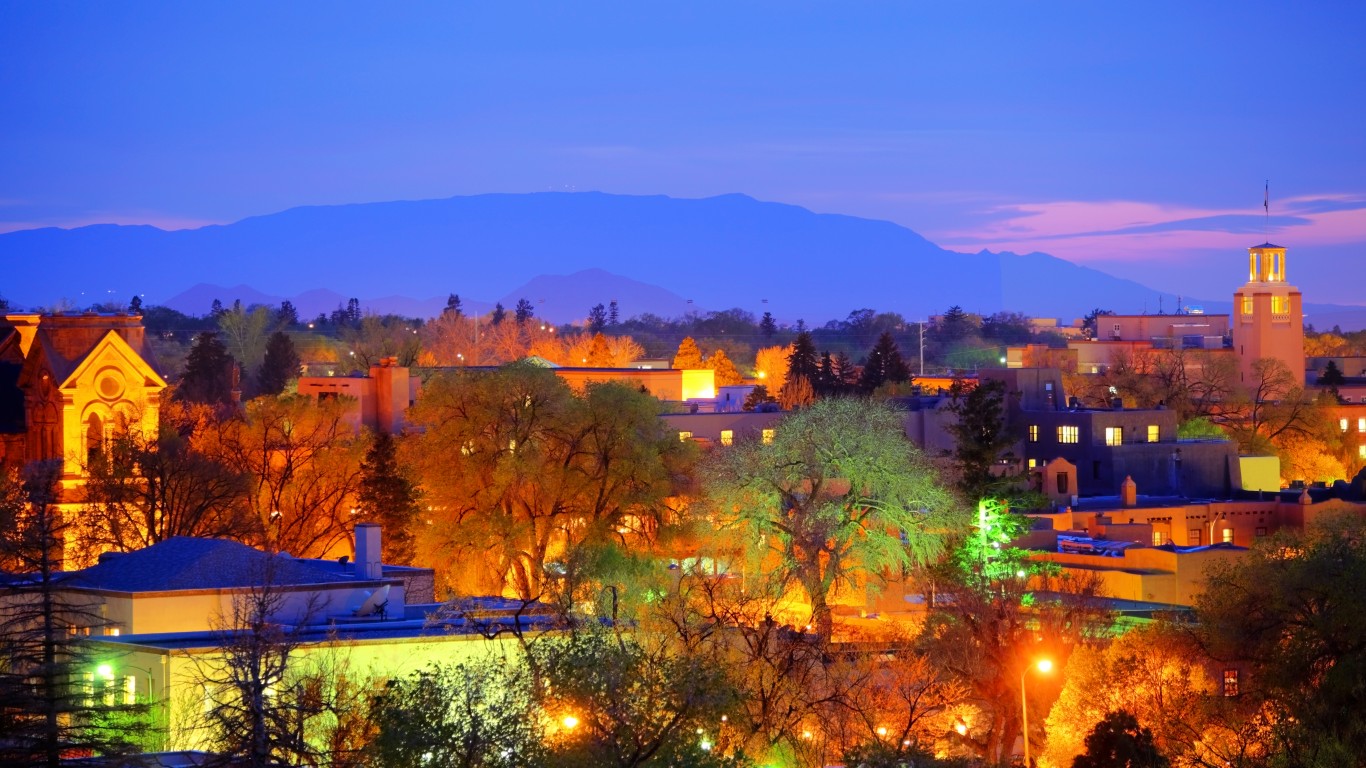
15. New Mexico
> Average teacher pay: $58,598 (20th lowest)
> Student-teacher ratio: 29 to 1 (16th highest)
> New teachers expected to qualify for a pension: 33.0% (13th lowest)
> High school graduation rate: 71.1% (the lowest)
After adjusting for New Mexico’s relatively low cost of living, the typical public school teacher’s salary is estimated at $58,598 — by no means the worst pay in the nation. However, with relatively large classroom sizes, low probability of new teachers staying in their professions until retirement, and poor grades by the National Council for Teacher Quality, New Mexico is among the worst states in which to be a teacher.
While high academic achievement and other favorable educational outcomes are often common even in states where it can be difficult to be a public school teacher, this is not the case in New Mexico. The percentage of fourth and eighth graders who scored “proficient” on the NAEP standardized tests, at 24.8% and 20.3%, are the 50th and 49th lowest in the nation. The state’s high school graduation rate of 71.1% is also the lowest out of all states.
[in-text-ad]

14. West Virginia
> Average teacher pay: $52,119 (7th lowest)
> Student-teacher ratio: 25 to 1 (15th lowest)
> New teachers expected to qualify for a pension: 25.0% (5th lowest)
> High school graduation rate: 89.4% (6th highest)
West Virginia public school teachers were at the forefront of a wave of teacher strikes that swept the nation last year. With demands including smaller class sizes, more staffing, and an end to charter school expansion, the strikes and other actions of teachers in the state led to a 5% pay raise in legislation passed last year.
Based on statistics used for this ranking, West Virginia’s teachers may have every right to demand better working conditions at their schools. For one, the state’s pension system does not appear to be serving its beneficiaries particularly well due at least in part to high turnover of teachers. Only one in every four new teachers in West Virginia are expected to remain in the profession long enough to qualify for pension benefits, the fifth lowest proportion of all states.

13. New Hampshire
> Average teacher pay: $56,006 (14th lowest)
> Student-teacher ratio: 22 to 1 (5th lowest)
> New teachers expected to qualify for a pension: 31.0% (10th lowest)
> High school graduation rate: 88.9% (10th highest)
The cost of living in New Hampshire is among the 10 highest in the United States, with prices about 6.0% higher than the national average. After adjusting for the state’s high cost of living, teachers in the state earn about $56,000 annually, significantly less than the average teachers’ pay of nearly $63,000 nationwide. The low share of new teachers expected to teach for enough years to qualify for retirement benefits of just 31.0% further lowers New Hampshire’s ranking on this list.
The pensions of teachers who do end up collecting their benefits in the state are also low. The average annual retirement benefit of about $19,600 is the seventh lowest of all states.

12. Alabama
> Average teacher pay: $58,145 (17th lowest)
> Student-teacher ratio: 32 to 1 (9th highest)
> New teachers expected to qualify for a pension: 39.0% (20th lowest)
> High school graduation rate: 89.3% (7th highest)
Small classroom sizes have been shown to be beneficial to both the learning experience of students and working conditions for teachers. A four-year longitudinal study published by the Center for Public Education found that small classroom sizes of 18 or fewer students is linked to better academic achievement. In Alabama, there are on average 32 students for every teacher, the ninth worst student-teacher ratio of all states.
Like in many other states where it is relatively difficult to be a teacher, public school teachers working in Alabama are not especially well paid compared to their peers nationwide. The cost of living-adjusted average annual teacher pay in the state is $58,145, versus the comparable national teacher pay of $62,898. In its annual evaluation of state education policy goals, The National Council on Teacher Quality awarded Alabama an F for its ability to retain effective teachers.
[in-text-ad-2]

11. Oregon
> Average teacher pay: $71,028 (5th highest)
> Student-teacher ratio: 36 to 1 (5th highest)
> New teachers expected to qualify for a pension: 46.0% (24th highest)
> High school graduation rate: 76.7% (2nd lowest)
Oregon has the second lowest high school graduation rate in the nation, at 76.7%. According to the National Council on Teacher Quality, Oregon’s education policies promoting teacher quality are severely lacking — the state received F grades in three of nine categories and an overall grade of D-.
Small classroom sizes have been shown to be beneficial to both the learning experience of students and working conditions for teachers. A four-year longitudinal study published by the Center for Public Education found that small classroom sizes of 18 or fewer students is linked to better academic achievement. In Oregon, the average classroom size is 36 students for every teacher, the fifth largest of all states.

10. Nevada
> Average teacher pay: $59,088 (24th lowest)
> Student-teacher ratio: 37 to 1 (4th highest)
> New teachers expected to qualify for a pension: 57.0% (10th highest)
> High school graduation rate: 80.9% (11th lowest)
Smaller classroom sizes have been shown to benefit both the students and the teachers by allowing educators to focus more on individual students, spend less time handling interruptions, and experience less stress on the job. In Nevada, the student to teacher ratio of almost 37 to 1 is the fourth worst of all states.
Additionally, the National Council of Teacher Quality has given an overall C- grade to the state’s teaching quality policies. Some of the weaknesses the report has identified include lack of support for leadership opportunities and no additional compensation for more experienced teachers.
[in-text-ad]

9. Utah
> Average teacher pay: $61,715 (24th highest)
> Student-teacher ratio: 41 to 1 (3rd highest)
> New teachers expected to qualify for a pension: 52.0% (18th highest)
> High school graduation rate: 86.0% (25th lowest)
Like Nevada, Utah’s teachers earn nearly the U.S. average for teachers’ annual pay, adjusted to the cost of living. Also, a relatively high share of new teachers is expected to work long enough to qualify for pension benefits. However, the state student-to-teacher ratio of 41 students per one teacher is the third highest of all states. Large class sizes can contribute to a more stressful work environment for teachers.
Contributing to Utah’s low ranking is also the National Council for Teaching Quality’s report on the state’s policies. There is plenty of room for improvement. The state for example does not require that tenure decisions are made on the basis of teacher performance, and there are few policies that reward teachers with more relevant experience.
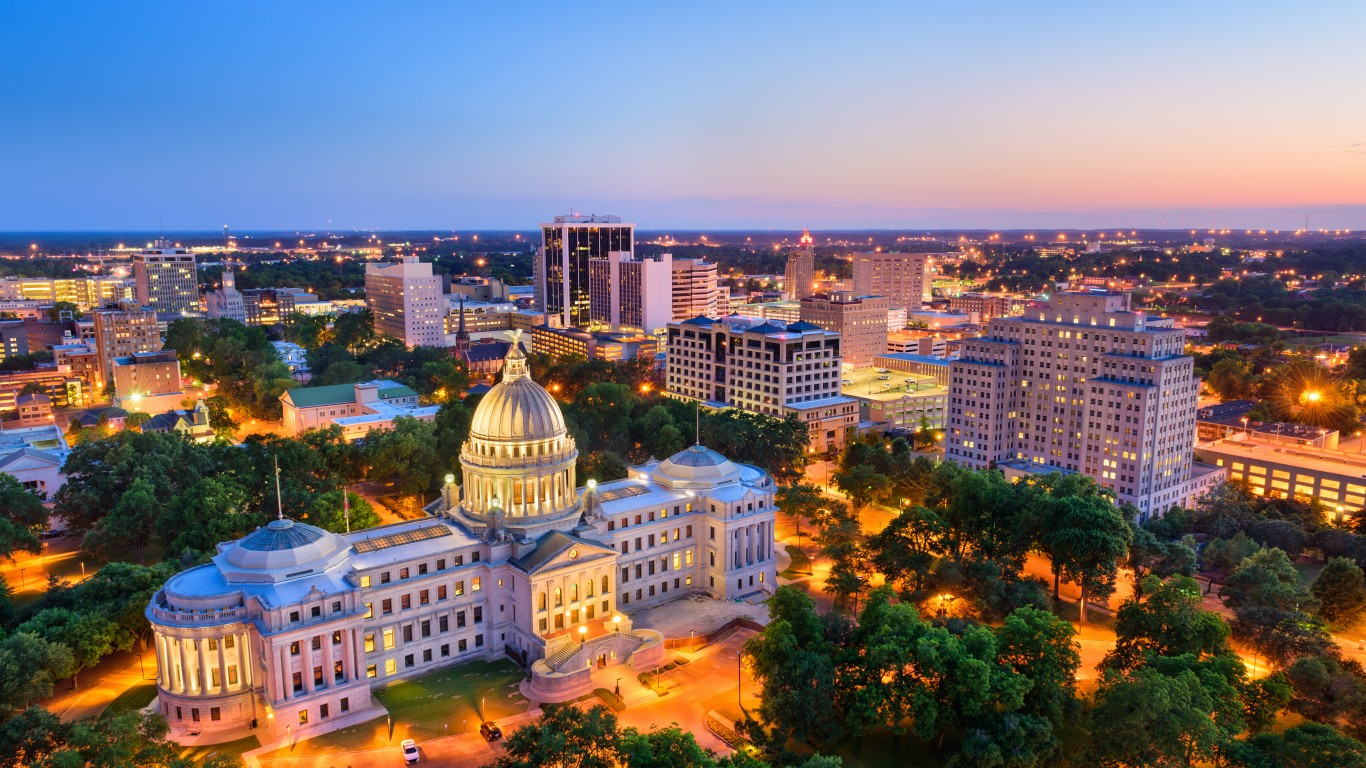
8. Mississippi
> Average teacher pay: $52,575 (9th lowest)
> Student-teacher ratio: 27 to 1 (25th highest)
> New teachers expected to qualify for a pension: 22.0% (3rd lowest)
> High school graduation rate: 83.0% (18th lowest)
As is the case in only two other states, less than one-quarter (22%) of new teachers in Mississippi are expected to stay in the profession long enough to qualify for a pension. For those who do end up retiring with benefits, the average pension is $18,928 annually, the sixth lowest of all states.
Mississippi has the nation’s lowest cost of living, with prices on average 14% lower than across the nation as a whole. Even after adjusting for cost of living, however, the state’s average annual salary for teachers of $52,575 is the ninth lowest of all states.

7. Maine
> Average teacher pay: $54,759 (11th lowest)
> Student-teacher ratio: 22 to 1 (4th lowest)
> New teachers expected to qualify for a pension: 14.0% (2nd lowest)
> High school graduation rate: 86.9% (19th highest)
Public school teachers in Maine benefit from small classroom sizes, which have been shown to be favorable to both students and teachers. With one of the lowest student-teacher ratios in the nation, the state is an exception on this list of worst states to be a teacher.
One of the factors driving the state’s poor ranking is its failure to provide retirement system that adequately supports teachers. Only 14% of new teachers in Maine are expected to remain long enough to qualify for pension benefits, which in Maine require a five year vesting period. Further, teachers in Maine are not permitted to take their benefits to other states, are extremely unlikely to receive in retirement payments that are equal to their total contributions, and an estimated 74% of teacher pension contributions go to debts created by poor state management.
[in-text-ad-2]
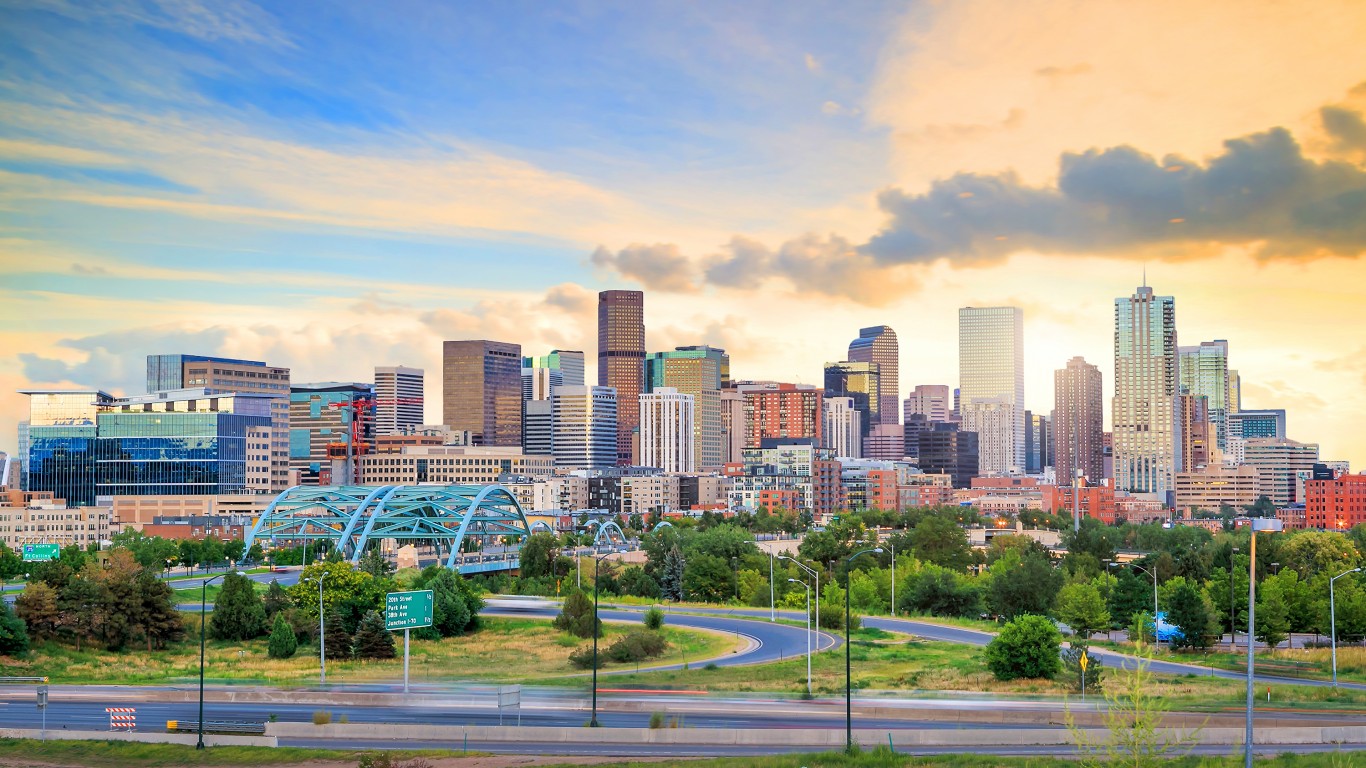
6. Colorado
> Average teacher pay: $52,357 (8th lowest)
> Student-teacher ratio: 31 to 1 (11th highest)
> New teachers expected to qualify for a pension: 36.0% (17th lowest)
> High school graduation rate: 79.1% (6th lowest)
Like most states where teaching is a relatively difficult profession, teachers in Colorado are paid relatively lower wages. Teachers earn on average just over $52,000 annually, the eighth lowest average teachers pay of all states, and well below the national average teachers pay of about $63,000.
Though teacher retirees in Colorado receive on average one of the highest retirement benefit amounts, just over a third of new teachers are expected to stay teaching in Colorado and qualify for retirement benefits. This may be partially due to the fairly stricter rules to collect benefits. Teachers can retire at any age after 35 years of teaching, more than the standard of 30 years, or at age 66 after any amount of service, also longer than the standard of 60 years.
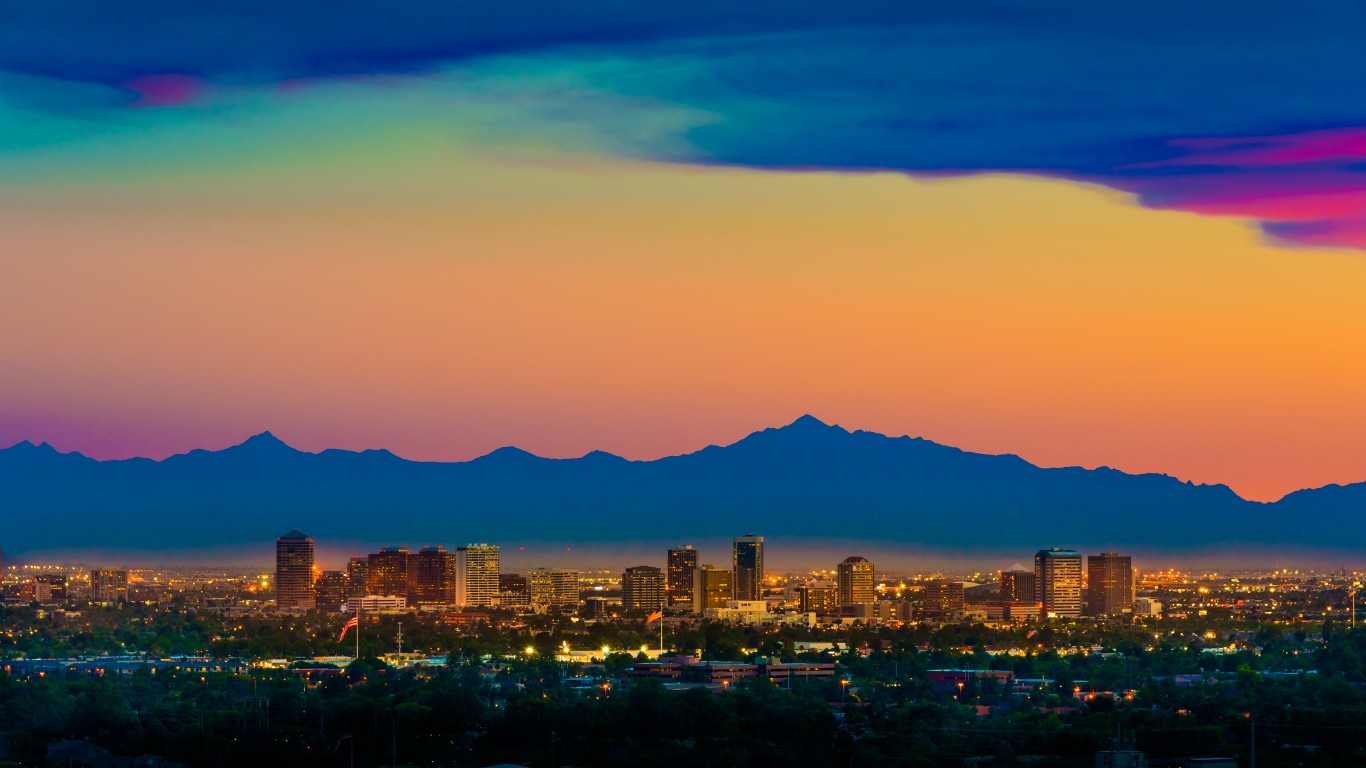
5. Arizona
> Average teacher pay: $47,597 (2nd lowest)
> Student-teacher ratio: 43 to 1 (the highest)
> New teachers expected to qualify for a pension: 100.0% (the highest)
> High school graduation rate: 78.0% (3rd lowest)
While all new teachers in Arizona are expected to stay in the profession long enough to qualify for retirement benefits, the average annual retirement benefit is low. At nearly $20,000, it is the eighth lowest of all states. Additionally, huge class sizes — with 43 students per every teacher, the highest teacher-student ratio in the country — only make teachers’ job harder and worsen both the learning experience and their working environment.
Teachers working in Arizona are not very well paid at all. The average annual pay, adjusted to the cost of living in the state, is almost $48,000. It is the second lowest average annual teacher compensation among states and almost $15,000 below the national average for teacher’s pay of almost $63,000.
[in-text-ad]

4. Hawaii
> Average teacher pay: $51,550 (4th lowest)
> Student-teacher ratio: 28 to 1 (19th highest)
> New teachers expected to qualify for a pension: 25.0% (5th lowest)
> High school graduation rate: 82.7% (17th lowest)
Hawaii has the nation’s highest cost of living, with prices on average 18.0% higher in the state than across the nation as a whole. After adjusting for the high living costs, the state’s average annual salary for teachers of $51,550 is the fourth lowest in the country.
Only a quarter of new teachers in Hawaii are expected to remain teachers long enough to qualify for retirement benefits, the fifth lowest share of teachers out of all states. The low retirement benefit for those teachers who do manage to retire of just over $9,000, the second lowest of all states, may contribute to turn over of public school educators.

3. Oklahoma
> Average teacher pay: $46,456 (the lowest)
> Student-teacher ratio: 29 to 1 (14th highest)
> New teachers expected to qualify for a pension: 44.0% (25th lowest)
> High school graduation rate: 82.6% (14th lowest)
Teachers in Oklahoma earn about a third less than the average teachers’ pay nationwide. The average annual pay in the state, adjusted to the cost of living, is $46,456, the lowest teacher salary of all states and considerably less than the U.S. average of almost $63,000.
Large class sizes are making teachers’ jobs more difficult. Research has shown that students are served better when teachers know them better, which is more likely in smaller classes. Further, small class sizes have been linked to several cognitive and non-cognitive benefits for both students and teachers. There are on average 29 students for every teacher in Hawaii, the 14th highest student-teacher ratio in the country.

2. Montana
> Average teacher pay: $55,705 (13th lowest)
> Student-teacher ratio: 25 to 1 (18th lowest)
> New teachers expected to qualify for a pension: 35.0% (15th lowest)
> High school graduation rate: 85.8% (24th lowest)
Even though teachers in Montana earn higher adjusted pays compared to the five worst states to be a teacher, only 35.0% of new teachers are expected to qualify for retirement benefits.
The National Council of Teacher Quality has given an F grade on the state’s teaching quality policies. When it comes to retaining effective staff, none of the measures, including supporting teacher leadership opportunities and considering effectiveness during layoffs, are implemented. The report lists no strengths at all in the state’s teaching quality policies.
[in-text-ad-2]
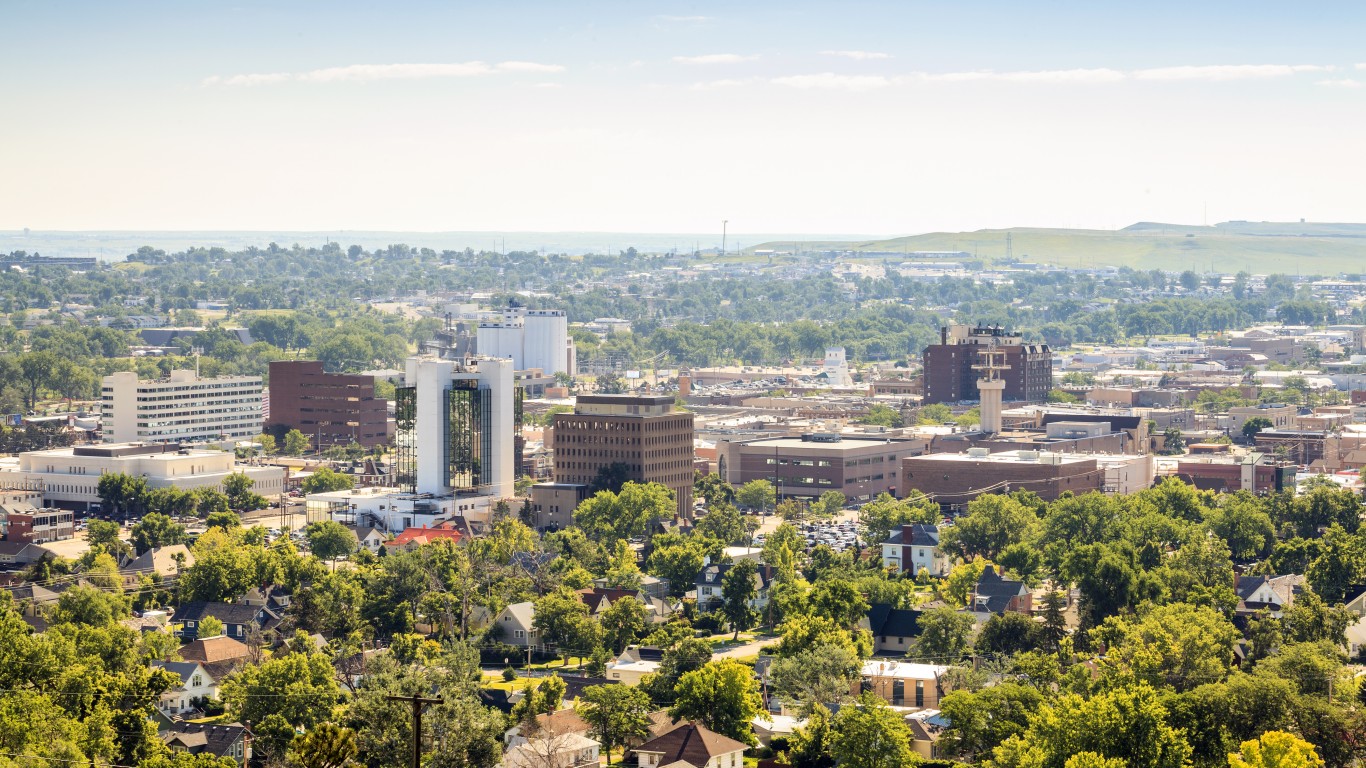
1. South Dakota
> Average teacher pay: $48,947 (3rd lowest)
> Student-teacher ratio: 25 to 1 (17th lowest)
> New teachers expected to qualify for a pension: 53.0% (17th highest)
> High school graduation rate: 83.7% (20th lowest)
South Dakota’s teachers’ pay, adjusted to the cost of living, is relatively low — third lowest of all states. Though more than half of new teachers are expected to qualify for employer-based retirement benefits, South Dakota still ranks last as the worst state to be a teacher. The average retirement benefit new teachers actually receive is the third lowest in the country at just over $16,000 annually.
The NCTQ has ranked the state’s various policies on making sure teachers are qualified with either F or D. That means South Dakota’s rules and regulations on issuing licenses and evaluating teachers’ progress are not very strict. The state’s overall grade is F, worse than the previous three years when it was awarded a D or D-.
To identify the states where it’s best (and worst) to be a teacher, 24/7 Tempo constructed an index of four measures:
1) Average annual pay, which was adjusted based on the Bureau of Economic Analysis’ 2016 cost of living measure, came from the Bureau of Labor Statistics’ May 2018 Occupational Employment Statistics (OES) program. These wage statistics were weighted for each state’s different primary, middle, and secondary employment composition.
2) Student-teacher ratio was computed by 24/7 Tempo using data obtained from the National Center for Education Statistics’ Common Core of Data (CCD). For this calculation, we counted teachers as defined by the CCD as any professional school staff member who instructs students in prekindergarten, kindergarten, grades one through 12, or ungraded classes, and maintains daily student attendance records. The number of students also came from the CCD.
3) The percentage of new teachers who are expected to qualify for a pension came from Teacher Pensions.org and is as of January 2019. This measure estimates the likelihood a new teacher will leave the profession before being entitled to receive retirement benefits.
4) The overall state quality grade given to each state by research and policy group the National Council for Teacher Quality’s 2017 annual report.
In addition to these four measures used for ranking the states, we reviewed a range of other related statistics. The percentage of high school students who graduate on time, measured by the adjusted cohort graduation rate (ACGR) is for the 2016–17 school year and came from the National Center for Education Statistics. National Assessment of Educational Progress (NAEP) test results for each state’s public fourth and eighth graders were obtained from news organization and research center Education Week’s 2019 Chance for Success report.
Credit card companies are pulling out all the stops, with the issuers are offering insane travel rewards and perks.
We’re talking huge sign-up bonuses, points on every purchase, and benefits like lounge access, travel credits, and free hotel nights. For travelers, these rewards can add up to thousands of dollars in flights, upgrades, and luxury experiences every year.
It’s like getting paid to travel — and it’s available to qualified borrowers who know where to look.
We’ve rounded up some of the best travel credit cards on the market. Click here to see the list. Don’t miss these offers — they won’t be this good forever.
Thank you for reading! Have some feedback for us?
Contact the 24/7 Wall St. editorial team.